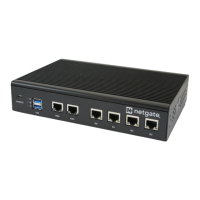Product Manual, TNSR 19.02
Installing TNSR on KVM
When creating the virtual machine, use the requirements on Supported Platforms as a guide for determining configu-
ration parameters before starting. For example:
• Number of CPUs, Cores, and their topology
• Amount of RAM
• Storage size
• Network connectivity type, number of interfaces, networks to which interfaces connect
Creating a VM
Before starting, obtain the installation ISO and place it in a known location.
The following command will create a new virtual machine from the KVM CLI with the following configuration:
• 2 virtual CPUs (1 socket, 2 cores per CPU, 1 thread per core)
– Set CPU to host or qemu64,+ssse3,+sse4.1,+sse4.2,+x2apic
• 4GB RAM
• A new 32GB virtio disk named tnsr.qcow2
• 3 virtio-based network interfaces
# virt-install --name TNSR --vcpus=2,sockets=1,cores=2,threads=1 \
--os-type linux --os-variant ubuntu20.04 --cpu host --ram 4096 \
--disk /var/lib/libvirt/images/tnsr.qcow2,size=32,device=disk,
˓→bus=virtio \
--network=default,model=virtio --network bridge=br0,model=virtio \
--network bridge=br1,model=virtio \
--nographics --noautoconsole \
--location /root/TNSR-Ubuntu.iso,kernel=casper/vmlinuz,initrd=casper/
˓→initrd \
--extra-args 'console=ttyS0,115200n8 quiet fsck.mode=skip \
network-config=disabled autoinstall ds=nocloud;s=/cdrom/server/'
Note: Replace the parameters as needed to conform to the local KVM environment. In particular, the --disk path,
ISO --location path, and bridge device or network names will likely be different.
Access the management console with the following command:
# virsh console TNSR
From the console, follow the standard TNSR installation procedure and the VM will shut down afterward. Start it
again and reconnect to the console:
# virsh start TNSR
# virsh console TNSR
KVM Frontends/GUIs can also accomplish the same goal in different ways. Use whichever method is preferred by the
hypervisor administrator.
1.3. Virtual Machines 60

